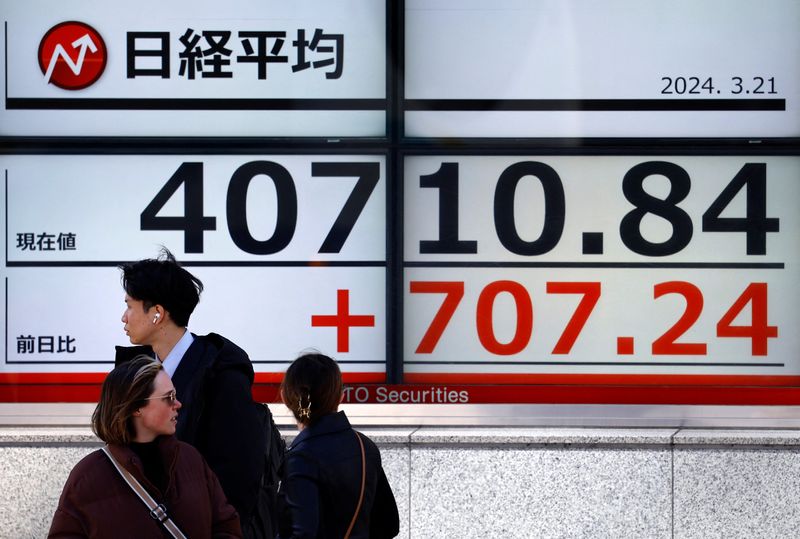By Rae Wee
SINGAPORE (Reuters) -The yen fell amid volatile trade on Friday after the Bank of Japan (BOJ) maintained its accommodative monetary policy stance at the conclusion of its two-day policy meeting, while Asian shares rose elsewhere.
The BOJ kept its short-term rates steady on Friday, as expected, while removing a reference to the amount of government bonds it has roughly committed to buying each month.
The Japanese yen fell shortly after the announcement to the weaker side of 156 per dollar, marking a fresh 34-year trough. It was last 0.25% lower at 156.04 per dollar.
Ten-year Japanese government bond futures came off lows. [JP/]
Focus now turns to BOJ Governor Kazuo Ueda’s news conference later on Friday for further details of the BOJ’s policy outlook.
Fears of an intervention from Tokyo to shore up the yen also remained high, given the yen’s decline to multi-decade lows against a resurgent dollar.
Japanese Finance Minister Shunichi Suzuki said on Friday the country is concerned about negative effects of the weak yen, adding to the slew of aggressive jawboning from authorities in recent weeks, though to little effect.
The Nikkei gained 0.8%.
Elsewhere, MSCI’s broadest index of Asia-Pacific shares outside Japan rose 0.76%. Hong Kong’s Hang Seng Index surged nearly 2%, while Chinese blue chips edged 1.1% higher.
U.S. stock futures jumped after tech giants Alphabet (NASDAQ:GOOGL) and Microsoft (NASDAQ:MSFT) reported quarterly results that beat Wall Street estimates.
Nasdaq futures advanced more than 1%, while S&P 500 futures rose 0.8%.
FED OUTLOOK
3rd party Ad. Not an offer or recommendation by Investing.com. See disclosure here or
remove ads
.
In the broader market, investors were digesting the implications of Thursday’s data, which showed the U.S. economy grew at its slowest pace in nearly two years in the first quarter, though inflation accelerated.
That reinforced expectations that the Federal Reserve would not cut interest rates before September.
“The U.S. Q1 GDP report delivered the worst of both worlds, softer than expected growth and higher than expected inflation,” said Rodrigo Catril, senior FX strategist at National Australia Bank (OTC:NABZY).
U.S. Treasury yields surged to five-month highs in the previous session and remained elevated in Asia. [US/]
The two-year yield hovered near the 5% level, while the benchmark 10-year yield steadied at about 4.700%.
The dollar, however, slipped on the back of the weaker U.S. growth, and was nursing some of those losses on Friday.
Sterling dipped 0.1 after touching a two-week high on Thursday, while the euro eased 0.05%. (FRX)
Focus now turns to March’s core PCE price index data due later on Friday – the Fed’s preferred measure of inflation – for further clues on the U.S. rate outlook.
“We don’t think inflation will give the Fed reason to tighten,” said James Reilly, a markets economist at Capital Economics.
“Granted, the PCE data… could present another ‘bump’ in the road, extending a succession of stronger-than-expected U.S. inflation and activity prints; but the Fed has already acknowledged that these would come,” Reilly added. “We continue to think that the disinflationary trend will reassert itself soon and that Fed cuts have therefore been delayed, not cancelled.”
3rd party Ad. Not an offer or recommendation by Investing.com. See disclosure here or
remove ads
.
In commodities, Brent edged 0.35% higher to $89.32 a barrel, while U.S. crude gained 0.3% to $83.81 per barrel. [O/R]
Gold rose 0.05% to $2,332.91 an ounce. [GOL/]
